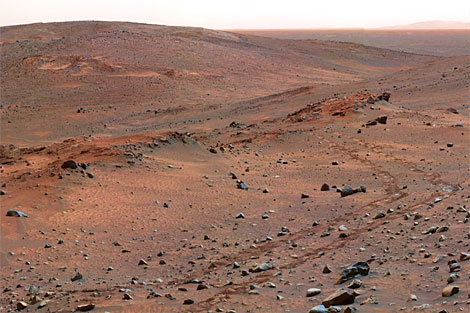

Laboratory tests aboard NASA's Phoenix Mars Lander have identified water in a soil sample. The lander's robotic arm delivered the sample Wednesday to an instrument that identifies vapors produced by the heating of samples.
With enticing results so far and the spacecraft in good shape, NASA also announced operational funding for the mission will extend through Sept. 30. The original prime mission of three months ends in late August. The mission extension adds five weeks to the 90 days of the prime mission.
"Phoenix is healthy and the projections for solar power look good, so we want to take full advantage of having this resource in one of the most interesting locations on Mars," said Michael Meyer, chief scientist for the Mars Exploration Program at NASA Headquarters in Washington.
The soil sample came from a trench approximately 2 inches deep. When the robotic arm first reached that depth, it hit a hard layer of frozen soil. Two attempts to deliver samples of icy soil on days when fresh material was exposed were foiled when the samples became stuck inside the scoop. Most of the material in Wednesday's sample had been exposed to the air for two days, letting some of the water in the sample vaporize away and making the soil easier to handle.
Since landing on May 25, Phoenix has been studying soil with a chemistry lab, TEGA, a microscope, a conductivity probe and cameras. Besides confirming the 2002 finding from orbit of water ice near the surface and deciphering the newly observed stickiness, the science team is trying to determine whether the water ice ever thaws enough to be available for biology and if carbon-containing chemicals and other raw materials for life are present.
The mission is examining the sky as well as the ground. A Canadian instrument is using a laser beam to study dust and clouds overhead.
"It's a 30-watt light bulb giving us a laser show on Mars," said Victoria Hipkin of the Canadian Space Agency.
A full-circle, color panorama of Phoenix's surroundings also has been completed by the spacecraft.
"The details and patterns we see in the ground show an ice-dominated terrain as far as the eye can see," said Mark Lemmon of Texas A&M University, lead scientist for Phoenix's Surface Stereo Imager camera. "They help us plan measurements we're making within reach of the robotic arm and interpret those measurements on a wider scale."
Read More
Mission Overview

Launched in August 2007, the Phoenix Mars Mission is the first in NASA's Scout Program. Phoenix is designed to study the history of water and habitability potential in the Martian arctic's ice-rich soil.
The Phoenix Mars Mission has a collaborative approach to space exploration. As the very first of NASA's Mars Scout class, Phoenix combines legacy and innovation in a framework of a true partnership: government, academia, and industry.
The scientists conducting the mission are using instruments aboard the Phoenix lander to search for environments suitable for microbial life on Mars, and to research the history of water there.
The multi-agency program is headed by the Lunar and Planetary Laboratory at the University of Arizona, under the direction of NASA's Jet Propulsion Laboratory. The program is a partnership of universities in the United States, Canada, Switzerland, Denmark, Germany, the United Kingdom, NASA, the Canadian Space Agency, the Finnish Meteorological Institute, Lockheed Martin Space Systems, MacDonald Dettwiler & Associates (MDA) and other aerospace companies.
Scout class missions are led by a scientist, known as a Principal Investigator (PI). Peter Smith of the University of Arizona's Lunar and Planetary Laboratory serves as Phoenix's PI and is responsible for all aspects of the mission.
The Phoenix Mission has a three-vertebrae backbone: the PI at the University of Arizona, the project manager at the Jet Propulsion Laboratory (JPL), and the flight system manager at Lockheed Martin Space Systems (LMSS). These three frequently communicate and ensure that decisions are understood and quickly implemented by the team.
Read More
Phoenix is the sixth successful landing on Mars, out of twelve total attempts (seven of which were American). It is the most recent spacecraft to land successfully on Mars. It is also the first successful landing on a polar region of Mars.
Read More
check out my Web Portal
No comments:
Post a Comment